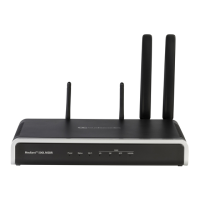User's Manual 830 Document #: LTRT-10466
Mediant 500L MSBR
Parameter Description
table parameter, SIPGroupName as the host name in the To
and From headers. If the IP Group is configured with a Proxy
Set that has multiple IP addresses, all the REGISTER
messages sent to these proxies are sent with the same host
name.
Note: If this parameter is disabled and the ProxyName
parameter is not configured, the proxy's IP address is used as
the host name in the REGISTER Request-URI.
Web: Redundancy Mode
EMS: Proxy Redundancy Mode
CLI: redundancy-mode
[ProxyRedundancyMode]
Determines whether the device switches back to the primary
Proxy after using a redundant Proxy.
[0] Parking = (Default) The device continues working with a
redundant (now active) Proxy until the next failure, after
which it works with the next redundant Proxy.
[1] Homing = The device always tries to work with the
primary Proxy server (i.e., switches back to the primary
Proxy whenever it's available).
Note: To use this Proxy Redundancy mechanism, you need to
enable the keep-alive with Proxy option, by setting the
parameter EnableProxyKeepAlive to 1 or 2.
Web: Proxy IP List Refresh Time
EMS: IP List Refresh Time
CLI: proxy-ip-lst-rfrsh-time
[ProxyIPListRefreshTime]
Defines the time interval (in seconds) between each Proxy IP
list refresh.
The range is 5 to 2,000,000. The default interval is 60.
Web: Enable Fallback to Routing
Table
EMS: Fallback Used
CLI: fallback-to-routing
[IsFallbackUsed]
Determines whether the device falls back to the Outbound IP
Routing table for call routing when Proxy servers are
unavailable.
[0] Disable = (Default) Fallback is not used.
[1] Enable = The Outbound IP Routing table is used when
Proxy servers are unavailable.
When the device falls back to the Outbound IP Routing table, it
continues scanning for a Proxy. When the device locates an
active Proxy, it switches from internal routing back to Proxy
routing.
Note: To enable the redundant Proxies mechanism, set the
parameter EnableProxyKeepAlive to 1 or 2.
Web/EMS: Prefer Routing Table
CLI: prefer-routing-table
[PreferRouteTable]
Determines whether the device's internal routing table takes
precedence over a Proxy for routing calls.
[0] No = (Default) Only a Proxy server is used to route calls.
[1] Yes = The device checks the routing rules in the
Outbound IP Routing table for a match with the Tel-to-IP
call. Only if a match is not found is a Proxy used.
Web/EMS: Always Use Proxy
CLI: always-use-proxy
[AlwaysSendToProxy]
Determines whether the device sends SIP messages and
responses through a Proxy server.
[0] Disable = (Default) Use standard SIP routing rules.
[1] Enable = All SIP messages and responses are sent to
the Proxy server.
Note: This parameter is applicable only if a Proxy server is
used (i.e., the parameter IsProxyUsed is set to 1).
Web: SIP ReRouting Mode
EMS: SIP Re-Routing Mode
CLI: sip-rerouting-mode
Determines the routing mode after a call redirection (i.e., a 3xx
SIP response is received) or transfer (i.e., a SIP REFER
request is received).

